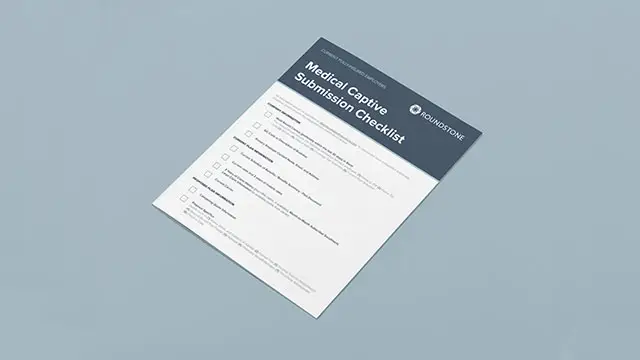Highlights
- Choosing the right employer health insurance plan is critical for your business and employees.
- With several options, including self-funded and traditional insurance, knowing the best plan for your employees can be challenging.
- While fully funded insurance offers familiarity, you have limited control over vendors and pharmacy benefits and may spend more than you need for coverage your employees don’t use.
- Joining a self-funded insurance group captive can give you the benefits of self-insurance, such as greater transparency and control, while minimizing the risks of self-funding.
When choosing employer health insurance for your small to midsize business (SMB), you have several options, including traditional fully funded insurance, level funding, self-funding, or a self-insured group captive. It’s helpful to familiarize yourself with your options and the benefits and considerations each provides.
Explore the following list of employer health insurance options, ranked from most to least advantageous to smaller businesses, and see how each stacks up against the group captive solution.
1. Self-Funded Insurance with a Stop Loss Group Captive – Why It’s Good for Employees
Self-funded group captive insurance allows small to midsize businesses to pool resources in a shared risk healthcare community and protect against volatility when they self insure. It enables a company with only 25 employees to deliver the same risk predictability as a Fortune 500 such as General Motors.
By self-insuring under a group medical captive model, several businesses band together to better predict and manage risk. The captive is used to pay for claims above the employer deductible, typically $15,000 to $40,000, and a set aggregate deductible. Each member of the group contributes to the funding of the captive pool, and claims made by members are paid in part out of the group’s pool of funds.
Claims above $500,000 are then paid by reinsurance, which helps manage the risk of catastrophic claims. When combined with stop loss insurance, a group captive makes self-funded insurance safe, reliable, and predictable.
Self-funded group captive insurance benefits SMBs by providing an alternative to traditional fully insured plans that often lack flexibility and have no transparency. Fully funded plans are also typically more expensive and have rising yearly premiums. The Kaiser Family Foundation reports that premiums have increased by 43% since 2012.
With a group captive in a self-funded insurance plan, businesses control the plan design and cost containment solutions to lower healthcare expenses. By pooling resources, smaller companies spread the risk of catastrophic claims and reduce insurance costs through a self-funded model.
Self-funded group captive insurance allows more control over insurance coverage and claims processing. Companies are free to choose their preferred third-party administrator (TPA), resulting in better plan utilization and employee satisfaction.
Self-funding under the group medical captive is good for employees because employers can tweak coverage to improve care quality while simultaneously driving down cost. The plan can be uniquely customized for the employees’ unique care needs, which simply isn’t possible under a traditionally fully insured plan.
2. Self-Funded Insurance
Self-funded health insurance is a risk management strategy in which a business chooses to fund its own insurance instead of purchasing coverage from an insurance company. With self-funding, the business assumes the risk of potential losses and sets aside funds to cover any claims that may arise.
Self-insurance allows businesses greater control over their insurance coverage and claims process. It also allows companies to choose their own provider network, vendors, and covered services. With a self-funded plan, your business can implement coverage for behavioral health and telemedicine services or start a Direct Primary Care plan to help employees access preventative care.
One drawback to self-funding is that it is typically only affordable for larger corporations with the resources to cover the volatility of self-insurance. In fact, among large firms with over 200 employees, 82% of workers are covered under a self-insured plan. Yet limited funds can make this option difficult for smaller businesses to implement.
However, small to midsize companies can benefit from self-funded insurance by joining a group captive plan in which they share the costs with other businesses of similar size.
By self-insuring under the group captive model, even a company with only 25 employees can leverage the same risk predictability as the Fortune 500s. By managing their own insurance, businesses can tailor their coverage to their specific needs and potentially save money on premiums.

3. Level-Funded
Level-funded insurance is marketed as a step between self-insurance and being fully insured. The reality is it’s often the worst of both worlds.
With level-funded insurance, a business pays a fixed monthly premium to the insurance company. This premium covers the expected cost of claims, administrative fees, and a stop-loss insurance policy. The business receives a refund if the claims made during the policy period are less than the fixed premium amount. If the claims exceed the fixed premium amount, the stop-loss insurance policy kicks in to cover the additional costs.
Level-funded insurance provides predictable costs and potential savings for businesses. Fixed monthly premiums allow companies to budget for healthcare expenses and save money compared to traditional insurance plans.
One major drawback of level-funded insurance is the increased risk. If the claims exceed the stop-loss coverage, businesses must be prepared to cover the cost, as the refund feature may not offset the expense.
Another significant drawback is a company typically does not get all of its unspent premium under a level-funded plan. They’re lucky if they get 50%, unlike a self-funded plan under the group captive model, which distributes 100% of unused claims account funds back and the stop loss captive’s underwriting surplus pro-rata.
Moreover, level-funded plans require you to renew before you see any of those savings, a tactic commonly referred to in the insurance industry as handcuffs. If you don’t renew, you aren’t refunded any unused claims. Roundstone’s captive approach to self-funding does not have handcuffs. You receive a refund on any unused captive funds pro-rata whether or not you decide to renew your plan.
4. Fully Insured
Fully insured (or fully funded) plans mean businesses pay a 100% fixed premium to an insurance company like Blue Cross or United Healthcare. The insurance provider then assumes responsibility for paying for covered healthcare services.
A benefit of traditional insurance is that it provides some predictability in terms of costs. The employer pays a fixed monthly premium, allowing for budgeting and financial planning. Fully insured plans also provide access to only a pre-selected network of healthcare providers and services.
Despite allowing for only 12 months of predictable budgeting, fully insured plans can be substantially more expensive than other types of insurance plans, particularly for SMBs. They often raise premium rates year-over-year, with little to no warning or input from members — and no transparency into why. With fully insured, you have no insight into your claims data and what can be done to lower costs or improve utilization.
Additionally, there is little flexibility for plan customization. Plan members can only access services and providers selected by the insurer, with little or no ability to implement cost containment solutions or better coverage options. You must choose a pre-packaged “bundle” and take what you get.
5. PEO
PEO (Professional Employer Organization) insurance allows smaller businesses to pool their resources together to obtain more affordable insurance coverage.
PEOs are companies that provide comprehensive HR services, including benefits administration, to small and midsize businesses.
The catch is that PEOs significantly add more administrative fees, so this isn’t a great option to lower cost for medical spend. These high management costs drive many cost effective companies away, further burdening those who choose to remain. And unlike self-insured plans, PEOS don’t provide prescription rebates, which are simply pocketed by the PEO.
Although PEO insurance can provide access to more affordable insurance coverage and benefits for smaller businesses, companies may experience increased costs when high claims are made. There is also minimal control over specific benefits and coverages and high administrative fees.
Why a Group Captive Plan with Roundstone is the Best Employer Health Insurance for Your Business
Roundstone group captive self-funded insurance plans are designed to help small to midsize businesses reduce their healthcare costs while providing quality coverage for their employees. With group captive insurance, multiple businesses pool premiums in a shared-risk layer, which helps to protect them. In a good year, they keep unspent premium in their own claims account and get a distribution of unspent premium from the captive, too. In a bad year, the captive can offset unexpectedly high claims expenses.
Here are the benefits of choosing a self-funded group captive plan with Roundstone.
Cost Savings
Self-insuring under Roundstone’s group captive reduces your financial responsibility by pooling member resources to spread the risk of high claims. You also gain access to proactive cost containment solutions and our CSI Dashboard, providing data and actionable insights to help save money on your plan and add value to your members’ care experience.
Roundstone captive members can save up to 20% on healthcare costs annually, and 100% of your unused premiums are returned at the end of the policy year. You also benefit from any pharmacy rebates that are passed on to you.
In fact, two-thirds of Roundstone customers save enough in their first four years to pay the claims for their entire fifth year. And 100% save money — full stop.
That’s the Roundstone Guarantee – you’ll save money in the first five years with us or we’ll make up the difference.

Flexibility and Customization
With a self-insured group captive plan with Roundstone, you design your own plan. You can customize benefits and coverage options to the needs of your employees. You also choose your own provider network, Third-Party Administrator (TPA), Pharmacy Benefits Manager (PBM), and vendors.
Transparency
Roundstone’s group captive self-insurance plans offer greater transparency and control over your healthcare costs. We provide detailed HIPAA-compliant claims data and analytics to help businesses make informed decisions about healthcare coverage, and our advisors work with members to identify cost savings opportunities they can implement throughout the year.
Optimized Cost Control
The beauty of a self-insured plan is you have detailed visibility into your costs, which means you can take active steps at cost containment to reduce costs and save money. Roundstone takes this a step further with a specialized team of Cost Savings Investigators, who comb through your data to identify potential savings. They make cost savings recommendations that you can implement to further drive down the cost of a self-funded plan.
More Is Spent on the Shared Layer, Faster Returns
Roundstone contributes greater spend into the captive than most captive solutions — 67 cents on the dollar — so there’s more potential for greater distribution when it comes to the refund you get back at the end of the year. Roundstone also pays back its refund on unspent captive quicker, at the end of the fiscal year, whereas many captive solutions pay 18 months to two years out.
Sizable Mass
With more than 700 employers protecting over 120,000 lives, Roundstone’s Group Medical Captive provides greater risk predictability, essentially leveraging a scale similar to a Fortune 500 company, even if you only have 25 employees.
Explore Self-Funded Employer Health Insurance With Roundstone
Roundstone’s self-funded group captive insurance offers the right combination of flexibility, transparency, and affordability while still providing quality care for your employees. With a customizable plan that offers maximum benefits at an affordable price, you’ll be able to control costs and save year after year.
Contact a Roundstone consultant today to discuss your company’s health insurance needs and discover how to reduce your insurance costs.











